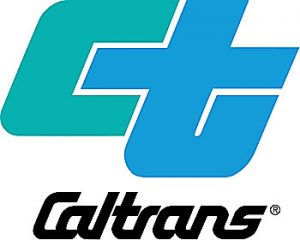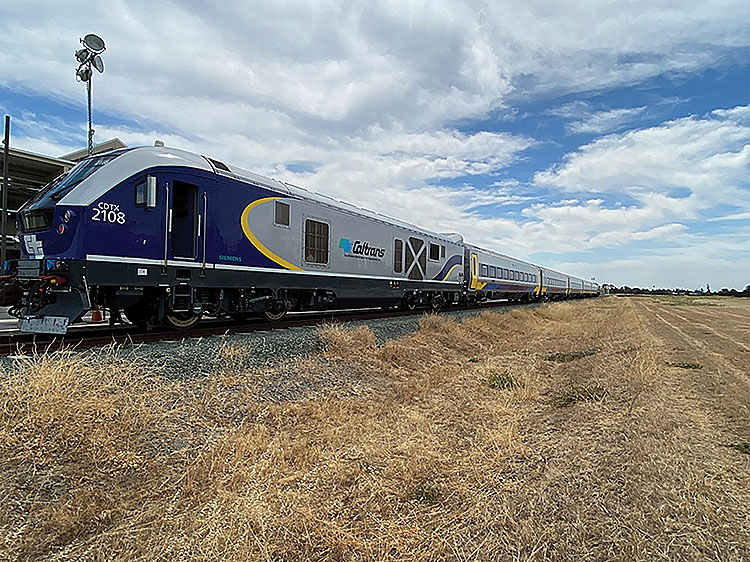Caltrans announces its passenger rail service on the route now offers travel on a new more accessible Venture by Siemens passenger rail car.
Seven are planned.
The run from the new station in Jack London Square takes 6.2 hours, according to Caltrans.
 Caltrans runs on the Pacific Surfliner, Capitol Corridor, and San Joaquins services. The San Joaquins feature the new passenger cars, with ADA-accessible aisles, doors, and restrooms, increasing transportation equity, state officials said. Individuals in wheelchairs can access the entire train.
Caltrans runs on the Pacific Surfliner, Capitol Corridor, and San Joaquins services. The San Joaquins feature the new passenger cars, with ADA-accessible aisles, doors, and restrooms, increasing transportation equity, state officials said. Individuals in wheelchairs can access the entire train.
When all of the new passenger cars are on the tracks by 2026, they will represent a $132 million investment in infrastructure spending.
The new cars are the first addition to the passenger rail fleet in more than 20 years.
Caltrans said 430 passengers can ride per trainset on the San Joaquins line, and 864,000 rode that train last year.
Caltrans Director Tony Tavares said, “These new rail cars encourage more people to get out of their cars and take the train. That lowers planet-warming pollution, improves air quality, shrinks our collective carbon footprint and further reduces our contribution to greenhouse gas emissions.”
A reviewer on YouTube noted the trainset does not include a café car to order food and drink; that was a decision by the San Joaquin Joint Powers Authority to replace it with a car with vending machines, prompting readers to voice their disappointment.
•••
Caltrans Turns to AI for Traffic Solutions
On May 9, Caltrans announced the first “generative artificial intelligence” contracts to address bottlenecks, pinpoint critical areas for biking and walking, prioritize locations that need safety improvements and achieve zero road fatalities and serious injuries by 2050.
Deloitte Consulting and INRIX were selected to investigate crash sites where people on foot or bicycle have been killed or injured, predict high-risk locations and propose potential solutions.
Accenture and Deloitte Consulting were selected to process and interpret data to improve traffic patterns, address bottlenecks, and improve traffic flow.
Contracts were awarded by Caltrans, with the California Department of Technology and the Department of General Services.
The state will pay each proof-of-concept vendor $1 to test in the “sandbox,” a secure and isolated testing environment. This gives the state and the vendors time to see what works, what doesn’t, and make adjustments during a 6-month window.
Generative AI is the next evolution of artificial intelligence, able to identify underlying patterns in data and produce something new, text, images, video. One example of generative AI is ChatGPT, developed by Open AI with funding from Microsoft.
“With an average of 12 Californians dying on our roadways every day, we need to use every tool available to end the roadway crisis and reach our goal of zero traffic fatalities and serious injuries by 2050,” said California Transportation Secretary Toks Omishakin. “Today represents an important step in exploring how GenAI can help save lives.”
Caltrans Director Tony Tavares added, “We are excited and optimistic of the ideas and solutions these vendors are working on in terms of improving safety on the highways and limiting gridlock in our busiest corridors.”
The vendors will collaborate with Caltrans to test their technology with publicly available data to determine if it can help find innovative solutions to two of the state’s most complex transportation challenges: Roadway safety and traffic management.
The AI contracts are in response to an executive order last September by Gov. Gavin Newsom tasking state agencies to study use of GenAI and begin a process to evaluate and deploy GenAI technology.
Caltrans and the state technology office will work with the vendors to evaluate the technology’s capability in a virtual testing environment.
According to the National Highway Traffic Safety Administration, the number of fatal and serious injury collisions in California, especially those involving pedestrians, cyclists and highway workers, is on the upswing.
With nearly 36 million registered vehicles on California roads, Caltrans is challenged in effectively analyzing data to get insights to address bottlenecks and improve traffic flow on more than 50,000 miles of highway and freeway lanes.
One of the challenges is the volume of data generated from traffic sensors, cameras, third-party data streams, photos, and incident reports.
Caltrans will also study AI technology to assess impacts of climate change at various locations and assess before and after impact of a infrastructure project on traffic patterns.



